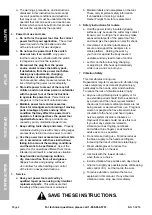
Page 13
For technical questions, please call 1-888-866-5797.
Item 58253
SA
FE
TY
OP
ERA
TI
O
N
MAINT
ENANC
E
SE
TUP
Record Product’s Serial Number Here:
Note: If product has no serial number, record month and year of purchase instead.
Note:
Some parts are listed and shown for illustration purposes only, and are not available
individually as replacement parts. Specify UPC 193175434715 when ordering parts.
Troubleshooting
Problem
Possible Causes
Likely Solutions
Tool will not start.
1. Cord not connected.
2. No power at outlet.
3. Tool’s thermal reset breaker
tripped (if equipped).
4. Internal damage or wear.
(Carbon brushes or
Power Switch, for example.)
1. Check that cord is plugged in.
2. Check power at outlet. If outlet is unpowered,
turn off tool and check circuit breaker.
If breaker is tripped, make sure circuit is right
capacity for tool and circuit has no other loads.
3. Turn off tool and allow to cool.
Press reset button on tool.
4. Have technician service tool.
Tool operates slowly. 1. Forcing tool to work too fast.
2. Extension cord too long or cord
diameter too small.
1. Allow tool to work at its own rate.
2. Eliminate use of extension cord. If an extension
cord is needed, use one with the proper diameter
for its length and load. See
Extension Cords
in
Grounding
section on page 5.
Performance
decreases over time.
1. Carbon brushes worn
or damaged.
2. Router bit dull or damaged.
1. Have qualified technician replace brushes.
2. Use sharp bits. Replace as needed.
Excessive noise
or rattling.
Internal damage or wear. (Carbon
brushes or bearings, for example.)
Have technician service tool.
Overheating.
1. Forcing tool to work too fast.
2. Accessory misaligned.
3. Router bit dull or damaged.
4. Blocked motor housing vents.
5. Motor being strained by long or
small diameter extension cord.
1. Allow tool to work at its own rate.
2. Check and correct accessory to
fence and/or table alignment.
3. Use sharp bits. Replace as needed.
4. Wear ANSI-approved safety goggles and
NIOSH-approved dust mask/respirator while
blowing dust out of motor using compressed air.
5. Eliminate use of extension cord. If an extension
cord is needed, use one with the proper diameter
for its length and load. See
Extension Cords
in
Grounding
section on page 5.
Follow all safety precautions whenever diagnosing or servicing the tool.
Disconnect power supply before service.


































